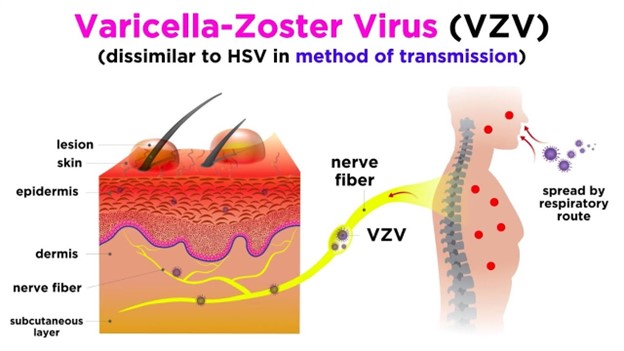A nurse is assisting with the admission of a client who has varicella zoster.
Which of the following interventions should the nurse plan to implement?
Assign the client to a negative pressure airflow room
Have visitors remain at least 0.91 m (3 feet) away from the client
Initiate contact precautions for the client
Administer aspirin if the client develops a fever
Correct Answer : A,C
Varicella zoster is highly contagious, and airborne precautions should be implemented. Assigning the client to a negative pressure airflow room helps prevent the spread of the virus to others by containing and filtering the air within the room.
In addition to airborne precautions, contact precautions should also be implemented. This includes using gloves and gowns when providing care to the client to minimize direct contact with infectious materials.

The other options listed are not appropriate interventions for a client with varicella zoster: While it is important to minimize close contact with an infectious client, varicella zoster is primarily transmitted through airborne droplets. Visitors should follow the appropriate precautions, such as wearing masks and adhering to hand hygiene, rather than just maintaining a certain distance.
Aspirin should not be given to clients with varicella zoster, especially children, due to the risk of developing Reye's syndrome. Reye's syndrome is a rare but serious condition that can cause swelling in the liver and brain. Acetaminophen (paracetamol) is typically recommended for managing fever in clients with varicella zoster.
Nursing Test Bank
Naxlex Comprehensive Predictor Exams
Related Questions
Correct Answer is B
Explanation
When a nurse encounters a client who has fallen, the immediate priority is to assess the client's condition and ensure their safety. By measuring the client's vital signs, the nurse can gather important information about the client's overall well-being, such as heart rate, blood pressure, respiratory rate, and oxygen saturation. This assessment helps determine if there are any immediate medical concerns resulting from the fall, such as injury or shock, that require prompt attention.
The other options listed are also important but should be addressed after the initial assessment and safety measures:
- Notify the client's provider: After assessing the client's condition, if there are significant injuries or concerns identified, the nurse should promptly notify the client's provider to seek further medical guidance and intervention.
- Complete an incident report: Reporting the fall incident is an essential part of ensuring quality and safety in healthcare. However, it is not the first action the nurse should take. The immediate focus should be on the client's assessment and safety. Completing an incident report can be done once the client's immediate needs are addressed.
- Document the fall in the client's medical record: Documenting the fall in the client's medical record is important for maintaining accurate and comprehensive documentation. However, it should be done after the client's assessment, vital sign measurement, and any necessary interventions have been carried out.
Correct Answer is A
Explanation
A- Apply a skin barrier protectant to the site: Using a skin barrier protectant helps shield the peristomal skin from irritation and breakdown caused by gastric contents and formula leakage.
B- Apply water-soluble lubricant to the site: Similarly, applying a water-soluble lubricant to the site is not a routine step in gastrostomy tube site care. Lubricants are typically used during the insertion of the tube or for intermittent tube feedings, but not for routine site care.
C- Tape the tube to the child's cheek: Taping the tube to the child's cheek is not necessary for routine site care. The tube should be secured using a dressing or device designed for gastrostomy tube stabilization, rather than taping it to the cheek.
D.Attaching an extension tube is related to administering feedings or medications rather than the maintenance and care of the gastrostomy site. Site care focuses on protecting the skin and ensuring cleanliness around the tube insertion area.

Whether you are a student looking to ace your exams or a practicing nurse seeking to enhance your expertise , our nursing education contents will empower you with the confidence and competence to make a difference in the lives of patients and become a respected leader in the healthcare field.
Visit Naxlex, invest in your future and unlock endless possibilities with our unparalleled nursing education contents today
Report Wrong Answer on the Current Question
Do you disagree with the answer? If yes, what is your expected answer? Explain.
Kindly be descriptive with the issue you are facing.
